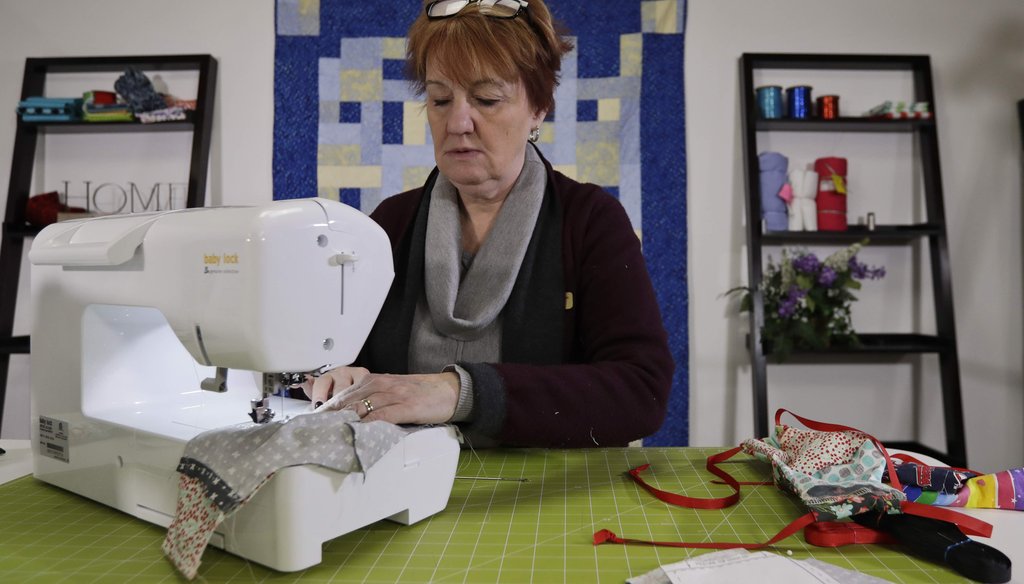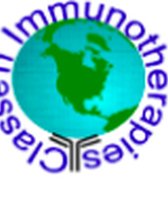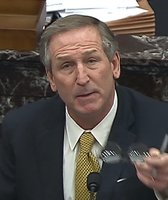Stand up for the facts!
Our only agenda is to publish the truth so you can be an informed participant in democracy.
We need your help.
I would like to contribute

Jan Brostek, owner of Pins and Needles, sews a mask for distribution to local hospitals on March 25, 2020, in Middleburgh Heights, Ohio. (AP)
If Your Time is short
-
The CDC is considering whether to change its guidance and ask healthy Americans to wear face masks while in public to prevent the spread of COVID-19.
-
With a national shortage of surgical masks, some groups are making their own out of cloth materials.
-
Homemade face masks aren’t as effective as surgical masks in preventing the spread of respiratory droplets. But thick or layered fabric may offer some protection, experts say.
Since the beginning of the COVID-19 outbreak, public health officials have advised healthy Americans not to wear face masks. The reason: There’s a shortage of masks, and they should be reserved for health care workers.
That guidance may change soon.
"When we get in a situation where we have enough masks, I believe there will be some very serious consideration about more broadening this recommendation of using masks," said Dr. Anthony Fauci, director of the National Institute of Allergy and Infectious Diseases, on CNN March 31. "We're not there yet, but I think we're close to coming to some determination."
One of the best ways Americans can avoid infecting others — even if they aren’t showing any coronavirus symptoms — is to wear a surgical mask when they’re out in public, Fauci said. But with shortages around the country, it’s hard for even health care workers to get them.
So some people have started to make their own. Homemade masks have become so popular that there are Facebook groups where avid sewers coordinate their efforts to provide protection for health care providers. Some hospitals are asking for homemade masks, while others won’t let their employees wear them while treating COVID-19 patients.
Several readers asked PolitiFact whether DIY masks are as effective at preventing the transmission of COVID-19 as the surgical ones. So we read the latest research and talked to experts.
We found that, while homemade face masks can serve as a potential alternative to surgical masks, they don’t offer the same level of protection. And their efficacy depends on what kind of material they’re made of and how they’re used.
First, let’s clear up how they work.
Face masks do not block some very fine particles in the air that may be transmitted by coughs or sneezes. That means they’re not a reliable way of preventing someone who’s wearing one from contracting the airborne coronavirus particles and getting COVID. But, since masks do prevent the spread of larger respiratory droplets, they are effective at preventing someone from spreading the virus to other people.
In its guidance to health care providers, the CDC says homemade masks like bandanas and scarves can be used as a last resort. Since their ability to protect against the coronavirus is unknown, the agency recommends that providers use them in combination with face shields and other protective equipment.
RELATED: Medical masks should be worn with the colored side out
Some health care providers are using homemade masks so that they can prolong the lifespan of the masks they do have, including the N95 respirators that filter out at least 95% of airborne particles.
"Some hospitals are creating masks, using homemade ones, that can be worn on top of the N95 masks," said Anna Adams, vice president of government relations at the Georgia Hospital Association. "The outer ones are washable, and that extends the life of N95."
Some hospitals have already started to run out of N95 respirators, and the CDC does not advise the American public to use them as a COVID-19 prevention measure. The current advisory says people infected with COVID-19 or living with someone who is should wear generic surgical masks.
Given the shortage of those face masks around the country, DIY masks could be effective at preventing the spread of the coronavirus. But they have to be made correctly.
The most effective homemade masks are made of thick cloth and make a tight seal around the wearer’s face.
"Given the current crisis, and lacking an alternative, many layers of densely woven fabric would be the most effective, because it allows for lots of voids in the layers where particles can be trapped," Richard Peltier, an assistant professor of environmental health sciences at the University of Massachusetts-Amherst, told us by email. "The mask needs to seal as tightly as possible to the face to avoid leaks, though this may not be possible with different designs, fabrics, or face shapes. Thin or porous fabrics are the least likely to be effective."
A study published in October 2010 tested how cloth masks and common fabrics fared when sprayed with aerosols at different speeds. All of the materials performed worse than N95 respirators. But some, such as cotton towels and scarves, were in the range of some surgical masks. The authors cautioned that fabric materials "show only marginal filtration performance against virus-size particles when sealed around the edges."
Another study from 2013 found that cotton masks only perform about half as well as surgical masks and "should only be considered as a last resort to prevent droplet transmission from infected individuals." More recent research had similar results.
So at best, using thick or layered fabric to make a homemade mask could be as effective as using some surgical masks. At worst, it prevents at least some of your respiratory droplets from spreading to others while in public.
RELATED: Fact-checking COVID-19 prevention, treatment myths
Under ideal circumstances, no face masks are intended to be worn for more than one encounter. That guidance also extends to homemade masks.
"At the end of the day, these cloth masks should be treated as contaminated materials that you bring in to your home — they need to be laundered in hot soapy water, and you’d need to consider sanitizing in bleach or hydrogen peroxide regularly," Peltier said.
Some experts have said face masks could also serve as a reminder to not touch your face, which is one of the ways the coronavirus spreads, according to the CDC. But Peltier said he’s not aware of any research that shows that’s the case. And there’s a chance that masks could actually encourage people to touch their face more since they can be uncomfortable to wear.
Still, since those infected with the coronavirus may not exhibit symptoms for up to 14 days after exposure, the CDC may soon advise everyone to wear masks in public just in case they’re sick. In that case, if you’re going out in public, wearing something is better than nothing.
Our Sources
The Annals of Occupational Hygiene, "Simple Respiratory Protection—Evaluation of the Filtration Performance of Cloth Masks and Common Fabric Materials Against 20–1000 nm Size Particles," October 2010
The Arizona Republic, "Will health care workers actually use homemade masks? Not while caring for COVID-19 patients," March 28, 2020
Centers for Disease Control and Prevention, Coronavirus Disease 2019 (COVID-19): Frequently Asked Questions about Personal Protective Equipment, accessed March 31, 2020
Centers for Disease Control and Prevention, Coronavirus Disease 2019 (COVID-19): How Coronavirus Spreads, accessed April 1, 2020
Centers for Disease Control and Prevention, Coronavirus Disease 2019 (COVID-19): How to Protect Yourself, accessed March 31, 2020
Centers for Disease Control and Prevention, Coronavirus Disease 2019 (COVID-19): Strategies for Optimizing the Supply of Facemasks, accessed March 31, 2020
Centers for Disease Control and Prevention, Coronavirus Disease 2019 (COVID-19): Symptoms of Coronavirus, accessed March 31, 2020
Centers for Disease Control and Prevention, Infographic - Understanding the Difference, Surgical Mask, N95 Respirator, accessed March 31, 2020
Centers for Disease Control and Prevention, NIOSH-Approved N95 Particulate Filtering Facepiece Respirators, accessed March 31, 2020
Centers for Disease Control and Prevention, Surgical N95 Respirators, accessed March 31, 2020
Consumer Reports, "Do You Need a Mask to Prevent Coronavirus?" March 25, 2020
C-SPAN, "President Trump Holds Coronavirus Briefing," March 31, 2020
Disaster Medicine and Public Health Preparedness, "Testing the Efficacy of Homemade Masks: Would They Protect in an Influenza Pandemic?" August 2013
Email interview with Richard Peltier, assistant professor of environmental health sciences at the University of Massachusetts-Amherst, March 31, 2020
Facebook group, accessed March 31, 2020
Food and Drug Administration, N95 Respirators and Surgical Masks (Face Masks), accessed March 31, 2020
Journal of Exposure Science & Environmental Epidemiology, "Evaluating the efficacy of cloth facemasks in reducing particulate matter exposure," Aug. 17, 2016
Live Science, "US hospitals are already starting to run out of respirator masks crucial for coronavirus protection," March 10, 2020
The New York Times, "A Sewing Army, Making Masks for America," March 25, 2020
The New York Times, "How to Stop Touching Your Face," March 5, 2020
The New York Times, "Should I Make My Own Mask?" March 31, 2020
NPR, "COVID-19 Has Caused A Shortage Of Face Masks. But They're Surprisingly Hard To Make," March 16, 2020
TV Eyes, accessed March 31, 2020
University Hospitals, Donations & Volunteer to Make Face Masks, accessed April 1, 2020
Vanderbilt University Medical Center, How to Donate Hand-Sewn Face Masks, accessed April 1, 2020
The Washington Post, "Simple DIY masks could help flatten the curve. We should all wear them in public." March 28, 2020


































